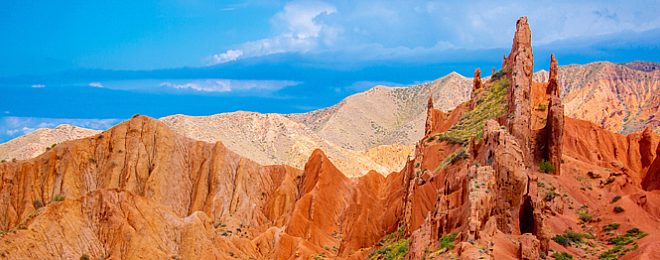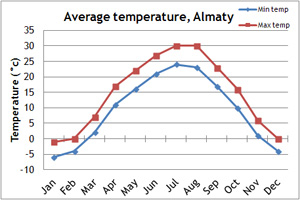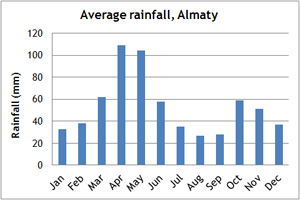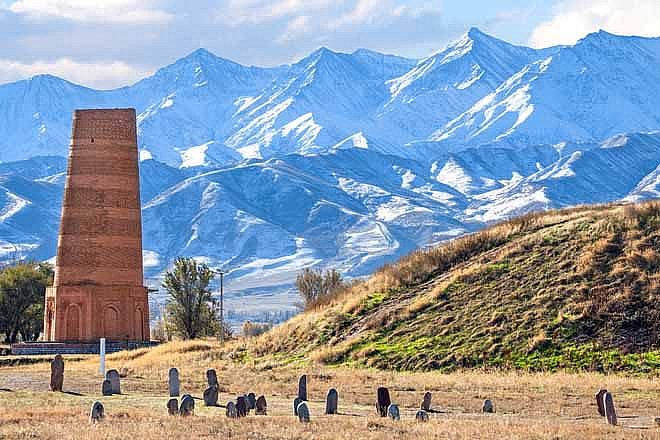Our grading system explained
Kazakhstan

The largest of the Five Stans, Kazkhstan has a myriad of natural wonders and a fascinating cultural heritage.
Show me:
1 Holiday
- Discover the splendours of the ancient Silk Road cities
- Explore ruined desert cities in the desert and important archaeological sites
- See natural wonders such as the Charyn Canyon and the ‘Gates of Hell’
- Enjoy the splendid scenery of the Fann Mountains
- Learn about the many artisan crafts of the region
- Try your hand at yurt building and archery
- Take in the modern-day highlights of Tashkent and Ashgabat
- Travel throughout with a Tour Leader plus local expert guides
Flight inclusive from £6490, Land only from £5750
- 1
Introduction
Kazakhstan is a huge country, stretching all the way from Siberia to the deserts of Turkmenistan and Uzbekistan. It is the 9th largest country in the world, the world’s largest landlocked country and is bigger than the whole of Western Europe. Its land borders, shared with Russia, China, Kyrgyzstan, Uzbekistan and Turkmenistan total 13,200 km. The country encompasses two time zones and five different climatic zones and its geography and terrain is immensely varied. While the country is mostly rather bleak steppe, there is spectacular scenery and snowcapped mountains to be found in the Tien Shan Mountains, which form a great natural boundary along Kazakhstan’s south eastern border with Kyrgyzstan. Kang Tengri (7,010m/22,999ft) is the jewel of the Tien Shan and is often considered to be one of the most beautiful peaks in the world. Other landscape attractions of Kazakhstan include the Charyn Canyon, often called Kazakhstan's Grand Canyon and Issyk Lake, a stunning turquoise-blue-green lake.
Kazakhstan has abundant natural and mineral resources and these and its wide open spaces have long made it very attractive to migrants and invaders, especially from Russia, and this accounts for its great ethnic diversity – over one hundred ethnic groups are said to live in the country. The Kazakhs, the original and largest ethnic group, were historically nomads related to the Mongols and Kazakhstan was controlled by the Mongols for more than 200 years, The Kazakh people remained largely nomadic until well into the 20th century which helps to explain why Kazakhstan has fewer ancient cities and ruins than the other Stans.
Much of Kazakhstan was integrated into the Russian Empire in the 19th century and the country finally gained its independence from the former Soviet Union only in 1991. The country sits on huge reserves of oil and mineral deposits, making it potentially one of the richest countries anywhere in Central Asia. Almaty, the largest city in Kazakhstan, has a beautiful setting between mountains and plains. It was formerly the capital, and its appearance and atmosphere is rather more Russian than Astana, which has been Kazakhstan’ capital since 1997. Astana, Kazakhstan’s new capital, is an attractive city, where money from the country’s huge oil profits has been spent on its extensive expansion and reconstruction, with architects such as the British architect Norman Foster being called in to help create a modern and vibrant city.
On our Five Stans of Central Asia tour, you will spend two days in Kazakhstan, vising the stunning Charyn Canyon and a replica of a traditional Kazakh village to give an insight into traditional nomadic Kazkh life.
Key Facts
• Capital city: Astana (since 1997)
• Population of Kazakhstan: 20,843,000 (2025)
• Size of country: 1,000,000 sq mi (2,700,000 square kilometres)
• Currency: Kazakhstani Tenge
• Power supply: 220 – 240 volts
• Sockets: European two-pin round variety
• Language: Kazakh, ‘the state language’, is spoken by 81% of the population. Russian is the ‘official’ language and is spoken by 83.7% of the population
• Time difference: GMT +5 hour
• Visas: You can visit Kazakhstan without a visa for up to 30 days for business or tourism.
• Religion: Muslim 47%, Russian Orthodox 44%, Protestant 2%, other 7%
• Popular dishes: The national dish is beshbarmak which is boiled meat (traditionally horse meat or mutton), served with a broth called shorpo over sheets of pasta.
• Popular drinks: The national drink is Kumys, made from fermented mare’s milk. Green tea is now more commonly drunk.
• Did you know: Lake Balkhash is the 15th largest lake in the world and is half fresh water and half saltwater - the lake's western part is fresh water and its eastern half is saline.
• FCDO travel advice
Climate
When is the best time to travel to Kazakhstan?
The climate of Kazakhstan is sharply continental and as with much of Central Asia, the country experiences hot, dry summers and icy cold winters. This means that the best time to visit Kazakhstan is between May and September. July, August and September are the optimum months for travel and trekking in Kazakhstan.







